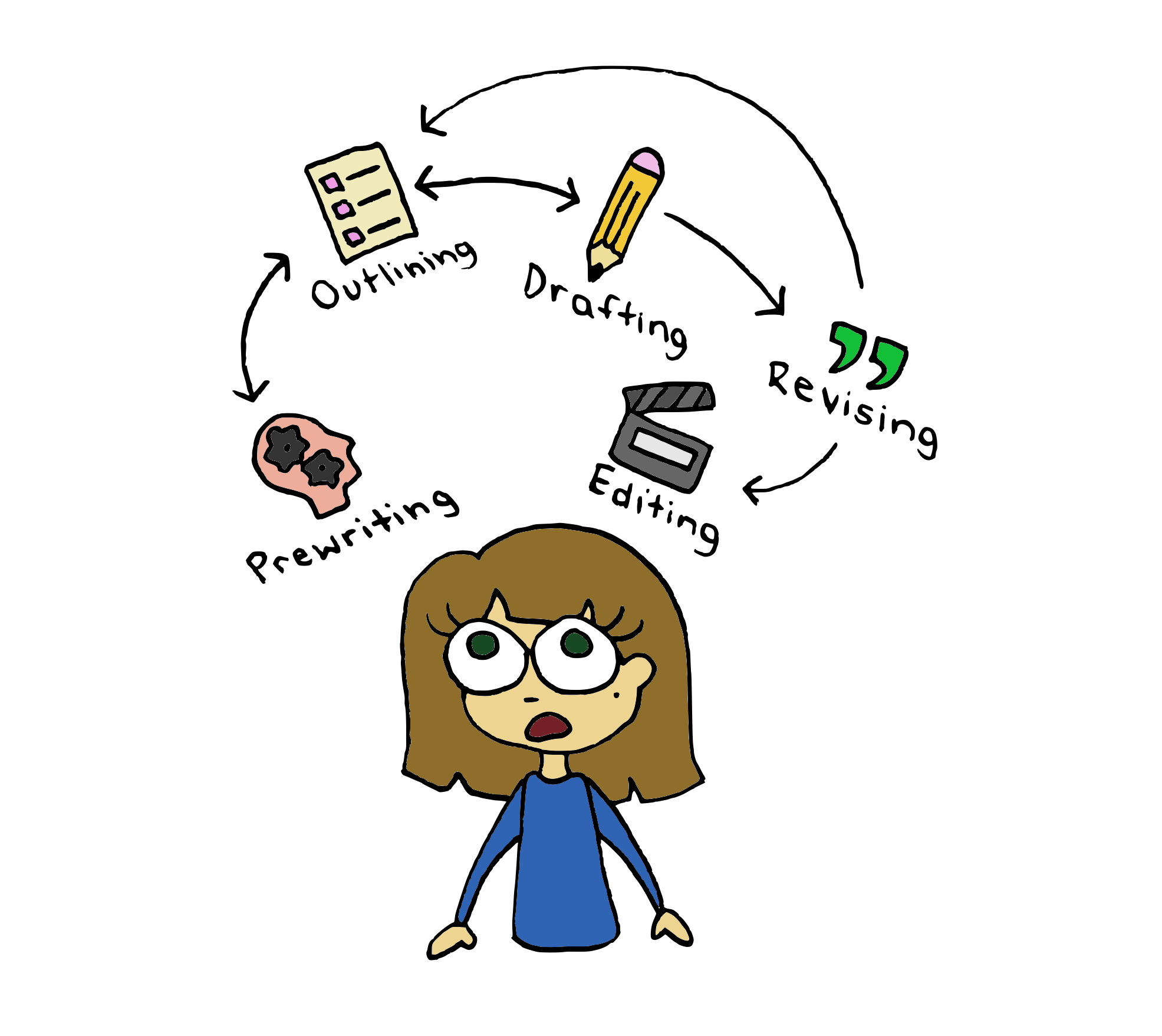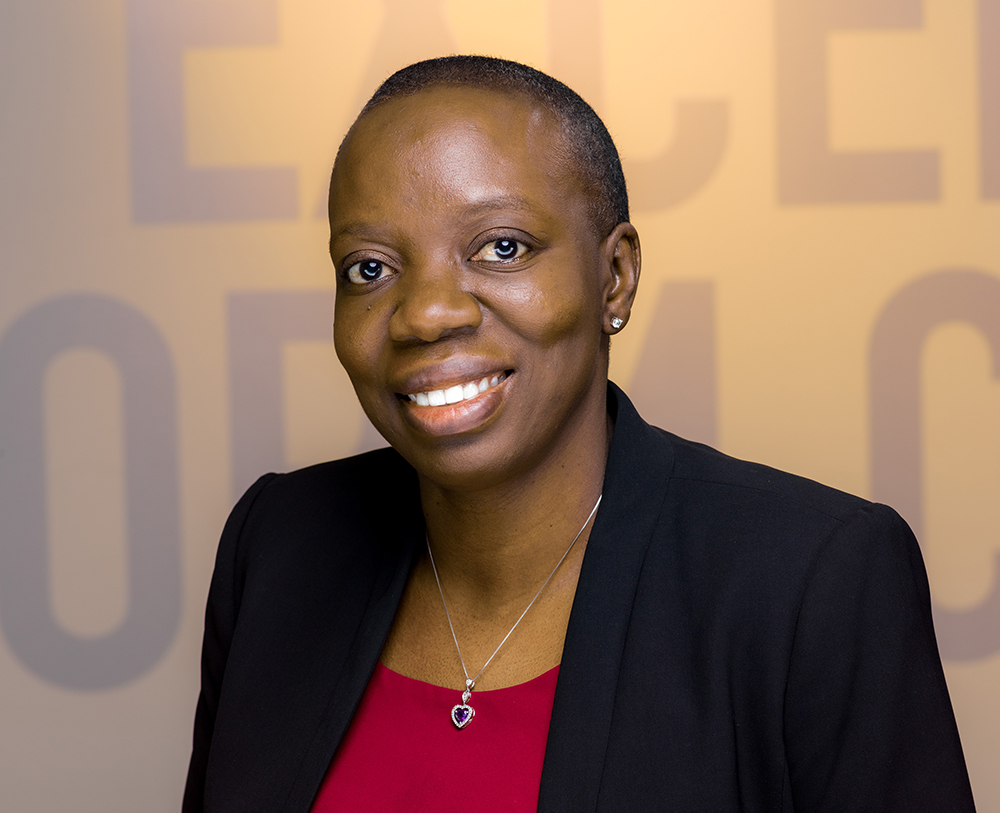Chapter 6: The Writing Process and Pre-Writing
Overview: The Writing Process
This chapter will introduce you to the writing process: the steps involved between receiving an assignment from your instructor to handing in your paper. Figure 6.1 illustrates the writing process.

Figure 6.1: The writing process
A successful writing project includes the following phases:
- Prewriting: Generate and begin to develop ideas to write about. As a starting point, read the writing assignment, determine what is required, and what you will focus on. You may need to conduct research during this phase.
- Outlining a structure of ideas: Determine the paper’s overall organizational structure and create an outline to organize these ideas. This phase usually involves elaborating on the initial ideas.
- Writing a rough draft: Use the work completed in the prewriting and outlining phases to develop a first draft. It should cover the ideas that you brainstormed and follow the organizational plan that you laid out.
- Revising: Review the draft and reshape its content to ensure it flows smoothly. This stage involves moderate and sometimes major changes: adding or deleting paragraphs, phrasing the main point differently, expanding on an important idea, reorganizing content, etc.
- Editing: Review the draft again to make changes that improve style and adherence to standard writing conventions. For example, you may replace a vague word with a more precise one, or correct errors in grammar and spelling. Once this stage is complete, the writing process is finished and your work is ready to share with others.
Check out Audio Podcast 6.1 in which Dr. Annette Bailey from the Daphne Cockwell School of Nursing at Toronto Metropolitan University shares her insights about writing and transferring your thinking onto paper.
Audio Podcast 6.1: Insights about writing [7:53]
See bottom of page for transcript of audio podcast 6.1
Student Tip
The Iterative Process of Writing
The writing process is not linear: you should move back and forth between the phases. For example, you might recheck the assignment guidelines to verify that your topic, pre-writing, and writing meets expectations. Or, you might brainstorm some ideas, do some research, and only then begin thinking about the main idea or thesis of your paper.
Activity: Check Your Understanding
Attribution statement
The writing process content was adapted from (with editorial changes):
Writing for Success 1st Canadian Edition by Tara Horkoff is licensed under a Creative Commons Attribution-NonCommercial-ShareAlike 4.0 International License, except where otherwise noted. Download for free at: https://opentextbc.ca/writingforsuccess/
_______________________________________
Transcript of audio podcast 6.1
Hello, my name is Dr. Annette Bailey, Associate Professor at the Daphne Cockwell School of Nursing. I’d like to take a few minutes to share some insights with you on the topic of writing. Over my years of teaching, I often hear students say they don’t have the writing skills to make meaning come alive on the pages. So I say to students, if they are able to think, they are able to write, because writing is about thinking. Writing is simply transferring your thinking onto paper. However, you must have the right thinking space, time, clarity of mind, and not be overly stressed to facilitate your deepest and most reflective thinking.
So how do you prepare for writing? Here are a few tips. 1. The critical first step in writing is to have a sound idea of the main message you want to relay. In other word what is your paper about? If you are writing a piece for yourself, you likely have an idea you are passionate about. If you are writing for an assignment, for which a topic is given, then you need to figure out how to put your spin on the topic. Ask yourself, what it is about this topic that I am passionate about, or what is of interest to me about this topic? Whenever possible, choose topics that you are curious about, or one you have an interest in pursuing knowledge on. 2. Secondly, create a detailed outline. once you have your topic and you know the main message you want to convey in your paper, begin writing ideas down related to that message, and use those ideas to create a detailed outline that you can use as a guide- one that provides a process or a sequence for building and connecting ideas in the paper. Once you have the basic outline, decide what you want to include under each heading or subheading in the paper, using bullet points. Then search the literature to find insights to support your ideas. You may also want to look for literature that may conflict your ideas or thoughts, so that you can build good debatable argumentation throughout your paper. Some writers do the literature research in advance of writing, I find that literature review occurs throughout the writing process for me, as I usually get new ideas in the process of writing that require support or substantiation. The literature is used to help bring clarity or expand on your ideas, or to build evidence into your paper. I usually encourage students not to simply rely on what the literature has to say. Bring your own ideas and ways of understanding what the literature has to say. Remember, you are using the literature to support your ideas, not the other way around. 3. Third, see the big picture of your paper. Look at your outline that you have created and try to see the big picture of your paper. As you document your ideas in the outline, ensure that ideas are coinciding throughout the paper, so that your finished paper does not appear fragmented. Ideas should link nicely throughout the paragraphs, the sections, and the entire paper. Look at this process of writing your paper like building a human being. Let me explain. Start with ideas (representing bones), connect ideas ( which is constructing the skeleton), support ideas with the literature (which is adding muscles to skeleton), bring originality and creativity to your ideas (which is adding organs), and build critical perspectives (which is like adding the brain). You have now built a scholar on paper! Originality, creativity and critical thinking are hallmarks of writing. So, bring your own unique ways of thinking into your writing. Critical thinking is not only about making sure that ideas are connected throughout the paper; it is also about the uniqueness of the ideas, and the ways in which they are presented to entice and excite the reader. Critical writing is about critical thinking, as I mentioned earlier. It is the critical things that come to mind that you then document on paper. Two writers can say something very similar, but the way it is written is the key to igniting a certain reaction from the reader. So, the way you use words matter. Never be afraid to use words creatively. Don’t let words scare you! But, having said that, it is important that you write in the most simplistic, easy to understand manner. There is an art to using simple words. Your simplest writing is the most sophisticated writing. Make your writing clear, ensure that ideas flow well, look at transition between your sentences, look at transition between paragraphs and sections of the paper. Your main message should be well woven throughout your entire paper. There is such thing called writers’ fatigue. If you find that you are having trouble generating ideas, maybe you have just spent 2 hours writing one paragraph, and the ideas are no longer emerging in your mind– try a different approach. How about speaking into an audio recorder, or exploring your ideas with a friend or family member while recording the conversation, or going for a walk to refresh and process your thoughts. What else can I tell you about writing? Well, writing is a messy process. You cannot write a polished paper without going through many different iterations. You will find that you are restructuring and rebuilding the paper as you progress in the writing process. So, it is important to start writing your paper early, so that you have enough time. That’s it for now. Be sure to check out my article- Building a scholar in writing (BSW): A model for developing students’ critical writing skills, published in the Nurse Education in Practice Journal


